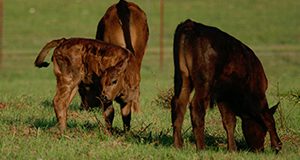 Nutrition can influence future health and performance of calves. The metabolic imprinting concept has substantial economic implications for animal agriculture, and it should be explored to improve the performance of animals bred for food production. This 6-page fact sheet summarizes some of the research conducted in beef calf nutrition and nutritional impact on growth and reproductive performance of beef calves. Written by Philipe Moriel, and published by the UF/IFAS Department of Animal Sciences, October 2017.
Nutrition can influence future health and performance of calves. The metabolic imprinting concept has substantial economic implications for animal agriculture, and it should be explored to improve the performance of animals bred for food production. This 6-page fact sheet summarizes some of the research conducted in beef calf nutrition and nutritional impact on growth and reproductive performance of beef calves. Written by Philipe Moriel, and published by the UF/IFAS Department of Animal Sciences, October 2017.
http://edis.ifas.ufl.edu/an335
Tag: beef calves
Additional Nutritional Considerations for Preconditioning Beef Calves
 Feed ingredient selection is not the only factor to consider during a preconditioning process. Recent studies demonstrated that diet composition and frequency of supplementation can have positive or negative effects on calf performance during preconditioning. This 7-page fact sheet focuses on the ways beef cattle producers can modify the nutritional composition of diets and frequency of concentrate supplementation to optimize growth and immunity of preconditioning beef calves or prevent detrimental effects. Written by Philipe Moriel, and published by the UF Department of Animal Sciences, September 2017.
Feed ingredient selection is not the only factor to consider during a preconditioning process. Recent studies demonstrated that diet composition and frequency of supplementation can have positive or negative effects on calf performance during preconditioning. This 7-page fact sheet focuses on the ways beef cattle producers can modify the nutritional composition of diets and frequency of concentrate supplementation to optimize growth and immunity of preconditioning beef calves or prevent detrimental effects. Written by Philipe Moriel, and published by the UF Department of Animal Sciences, September 2017.
http://edis.ifas.ufl.edu/an334